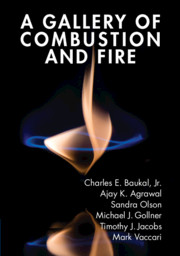Book contents
6 - Fires
Published online by Cambridge University Press: 17 June 2020
Summary
Scientists have long studied fire in an effort to both understand the world around them and to prevent the destruction and devastation that uncontrolled fires can cause. Despite many advances in the understanding of fire phenomena, society offers continued challenges that require new approaches for the prevention and mitigation of unwanted fires. In this chapter, fire research is presented through a series of photographs that scale from small, buoyant flames in the laboratory up to large, uncontrolled wildfires and even fire whirls.
- Type
- Chapter
- Information
- A Gallery of Combustion and Fire , pp. 140 - 175Publisher: Cambridge University PressPrint publication year: 2020



